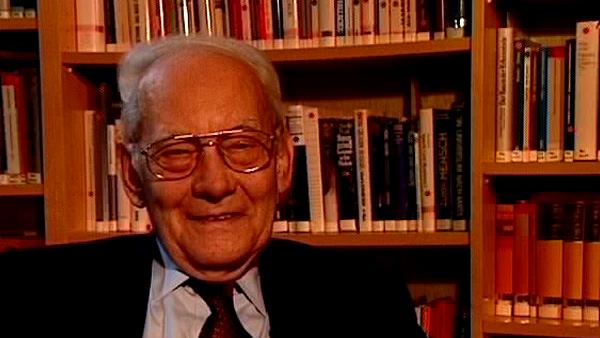Why do you need reproduction, you can ask. Well, because of complexity of those molecules. Look, the smallest living unit on a molecular level is a gene. A gene encodes a protein molecule, and the protein is the smallest living... the smallest molecular entity in a living organism. Now the smaller protein molecules we deal with are made up of, say, a hundred amino acids, and you know an amino acid... there are twenty classes of amino acids... and each amino acid is encoded by a triplet of nucleic acid building blocks, the A, U, G and C we talked before. So that means the smallest genes are several hundred of these monomers of the four-letter alphabet - AUGC or ATGC. The T and the U are very similar molecules, one is used as a ribonucleic acid, the other is used in the dioxyribonucleic nucleic acid. But most genes, in fact, are about a thousand such monomers, and now you see what I mean by complexity.
Take in the first position of the gene, you can have either an A, a T, a G, or a C, so there are 4 possibilities. Now comes the second position, you can have again 4, so in a dimer you have 4 by 4, 4 x 4 possibilities. In a trimer 4 x 4 x 4, and for each position you multiply that by 4. So that means if you have 300 positions, you have 4300, or if you have a thousand positions you have 41000. What does it mean? In the decimal system the logarithm of 4 is .6, so 41000 is 10600, a 1 with 600 zeros. And one of these molecules is the one you are dealing with, and you must conserve this information. So you see, you have so many alternatives that... and information which once appears never would come again, unless you reproduce. That's the need, the necessity, for reproduction.
I can perhaps give you some example. The physicists now can calculate how much matter we have in the universe. They don't know it exactly because they don't know the dark matter yet and they don't know whether the neutrino has a finite mass, but it's in the neighbourhood of 1080-82, 1082, so the '1' with 80-odd zeros, that's a number which is absolutely small, negligible as compared to the numbers I gave you before, 10600. So what can you say?
[Q] But you forgot to mention the unit 1080, in what unit?
Oh yes, yes, good for you. The smallest mass of a particle, a proton mass... 1080 masses of protons, not more. Then you can just as well calculate the volume of the universe and say let's assume the volume of the universe made up of little cells and let's make each cell of the size of a proton. That means it has a dimension of 10-8 cm, that's 1 angstrom unit, in a cubic array, so let's use as a unit the cubic angstrom, that means 10-8 cm in each direction. The total universe, or a sphere with a radius of 10 billion light years, has a volume of 10107 such cubic angstroms... only 10107. So you see the universe is by far too small, and its existence time to the big bang, these are 1017 seconds. It doesn't live long enough to test out all possible molecules which we have in our genes. So absolutely this is complexity, combinatorial complexity. If you don't reproduce that you lose it forever.





